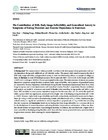| dc.contributor.author | Zou, Liye | |
| dc.contributor.author | Yang, Peiying | |
| dc.contributor.author | Herold, Fabian | |
| dc.contributor.author | Liu, Weina | |
| dc.contributor.author | Szabo, Attila | |
| dc.contributor.author | Taylor, Alyx | |
| dc.contributor.author | Sun, Jing | |
| dc.contributor.author | Ji, Liu | |
| dc.date.accessioned | 2023-03-08T15:13:47Z | |
| dc.date.available | 2023-03-08T15:13:47Z | |
| dc.date.issued | 2022-09-28 | |
| dc.identifier.citation | Zou, L., Yang, P., Herold, F., Liu, W., Szabo, A., Taylor, A., Sun, J. & Ji, L. (2022). The contribution of BMI, body image inflexibility, and generalized anxiety to symptoms of eating disorders and exercise dependence in exercisers. International Journal of Mental Health Promotion, 24(6), 811-823. https://doi.org/10.32604/ijmhp.2022.024862 | en |
| dc.identifier.issn | 2049-8543 | |
| dc.identifier.uri | https://aecc.archive.knowledgearc.net/handle/123456789/176 | |
| dc.description | Available under License - Create Commons Attribution: https://creativecommons.org/licenses/by/4.0/ | en |
| dc.description.abstract | 1) Background: The common factors which potentially contribute to the development of eating disorders and exercise dependence during early adulthood are still relatively unclear. The present study aimed to examine the role of BMI, body image inflexibility, and generalized anxiety in these two behavioral problems in a sample of college students. 2) Methods: In total, 878 habitual exercisers (58.1% male with BMI = 22.12 ± 2.39; 41.9% female with BMI = 20.55 ± 2.21) with age of 20.09 ± 1.76 years participated in this study. The main outcomes of interest are exercise dependence symptoms, eating disorders symptoms, body image inflexibility, and symptoms of generalized anxiety (as measured by Exercise Dependence Scale-Revised, Eating Disorder Examination-Questionnaire-Short Form, Body Image Acceptance and Action Questionnaire, and Generalized Anxiety Disorder-7, respectively). Pearson correlation, path analysis, and model fit information were tested. 3) Results: After controlling for age, gender, and field of study, lower BMI was linked to more exercise dependence symptoms but this association was not statistically significant, while a greater BMI was significantly associated with a higher risk of developing eating disorders (β = −0.08, p < 0.001). Moreover, higher body image inflexibility significantly and positively contributed to severe exercise dependence (β = 0.26, p < 0.001) as well as abnormal eating attitudes and behaviors (β = 0.74, p < 0.001). Furthermore, generalized anxiety is a significant contributor to exercise dependence symptoms (β = 0.14, p < 0.001) but not eating disorders symptoms. 4) Conclusion: Based on our finding that body image inflexibility is a common risk factor for the development of exercise dependence and eating disorders, the prevention and treatment of these two disorders should involve the improvement of psychological flexibility. In addition, the individual with a higher BMI is more vulnerable to developing eating disorders, while those who have severer generalized anxiety symptoms should be given more attention when screening for exercise dependence. | en |
| dc.language.iso | en | en |
| dc.publisher | International Journal of Mental Health Promotion | en |
| dc.subject | Anxiety | en |
| dc.subject | Body image | en |
| dc.subject | Exercise addiction | en |
| dc.subject | Eating disorders | en |
| dc.title | The contribution of BMI, body image inflexibility, and generalized anxiety to symptoms of eating disorders and exercise dependence in exercisers | en |
| dc.type | Article | en |
| dc.identifier.doi | https://doi.org/10.32604/ijmhp.2022.024862 | |
